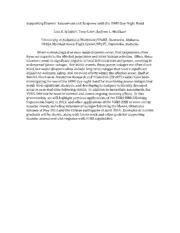
NASA Technical Reports Server (NTRS) 20150002880: Supporting Disaster Assessment and Response with the VIIRS Day-Night Band PDF
Preview NASA Technical Reports Server (NTRS) 20150002880: Supporting Disaster Assessment and Response with the VIIRS Day-Night Band
Supporting Disaster Assessment and Response with the VIIRS Day‐Night Band Lori A. Schultz1, Tony Cole1, Andrew L. Molthan2 1University of Alabama in Huntsville/SPoRT, Huntsville, Alabama 2NASA Marshall Space Flight Center/SPoRT, Huntsville, Alabama When meteorological or man‐made disasters occur, first responders often focus on impacts to the affected population and other human activities. Often, these disasters result in significant impacts to local infrastructure and power, resulting in widespread power outages. For minor events, these power outages are often short‐ lived, but major disasters often include long‐term outages that have a significant impact on wellness, safety, and recovery efforts within the affected areas. Staff at NASA’s Short‐term Prediction Research and Transition (SPoRT) Center have been investigating the use of the VIIRS day‐night band for monitoring power outages that result from significant disasters, and developing techniques to identify damaged areas in near real‐time following events. In addition to immediate assessment, the VIIRS DNB can be used to monitor and assess ongoing recovery efforts. In this presentation, we will highlight previous applications of the VIIRS DNB following Superstorm Sandy in 2012, and other applications of the VIIRS DNB to more recent disaster events, including detection of outages following the Moore, Oklahoma tornado of May 2013 and the Chilean earthquake of April 2014. Examples of current products will be shown, along with future work and other goals for supporting disaster assessment and response with VIIRS capabilities.
